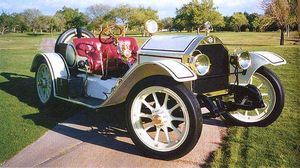.
Stutz Bearcat: Difference between revisions
Red marquis (talk | contribs) No edit summary |
Red marquis (talk | contribs) |
||
| Line 64: | Line 64: | ||
Owning a Stutz Bearcat became a famous status symbol for the very wealthy of the era. | Owning a Stutz Bearcat became a famous status symbol for the very wealthy of the era. | ||
{{-}} | {{-}} | ||
<gallery> | |||
</gallery> | |||
==Modern Bearcat== | ==Modern Bearcat== | ||
Revision as of 06:17, 14 June 2007
The Stutz Bearcat was an American luxury high-performance sports car made by the Stutz Motor Company. An evolution of the company's 1911 roadster, the Bearcat name lasted from 1914 through 1939. A later Bearcat was produced in the 1970s and 1980s by the revived Stutz Motor Car of America company.
Classic Bearcat

| |
| Stutz Bearcat | |
|---|---|
| Stutz | |
| aka | {{{aka (Type here, not up there)}}} |
| Production | {{{produced from when to when+total units made (optional)}}} |
| Class | {{{Class}}} |
| Body Style | {{{Body-Style}}} |
| Length | {{{length - type here}}} |
| Width | {{{Width - type here}}} |
| Height | {{{Height - type here}}} |
| Wheelbase | {{{wheelbase - type here}}} |
| Weight | {{{Weight - you get the point}}} |
| Transmission | {{{transmission + drive}}} |
| Engine | {{{engine}}} |
| Power | {{{Horsepower and Torque rating}}} |
| Similar | {{{similar (competition)}}} |
| Designer | {{{Designer (lead designer if it was a team effort)}}} |
The original Bearcat was based on the company's competitive 1911 Indy car and featured a powerful 361 in³ (5.9 L) "T-head" straight-4 engine. Output was 50 hp (37 kW), and the transmission was placed in the rear as in a modern transaxle. A later I6 version of the T-head engine produced 80 hp (60 kW).
The original Bearcat lasted from 1914 through 1917. It used a 6388 cc I4 engine.
The car's "underslung" design was unusual for the time, and its low weight, balance, and power made it an excellent racer. For example, in 1912, Stutz Bearcats won 25 of the 30 auto races they were entered in. But the Bearcat was sparse, with no doors and a tiny "monocle" windscreen in front of the driver.
The Bearcat was also the car used in Erwin "Cannon Ball" Baker's record coast-to-coast drive, inspiration for the later Cannonball Run outlaw race and film spinoffs. Baker drove his Bearcat from California to New York in eleven days, seven hours, and fifteen minutes, shattering the previous record.
Owning a Stutz Bearcat became a famous status symbol for the very wealthy of the era.
Modern Bearcat
| {{{Image}}} | |
| Stutz Bearcat | |
|---|---|
| Stutz | |
| aka | {{{aka (Type here, not up there)}}} |
| Production | {{{produced from when to when+total units made (optional)}}} |
| Class | {{{Class}}} |
| Body Style | {{{Body-Style}}} |
| Length | {{{length - type here}}} |
| Width | {{{Width - type here}}} |
| Height | {{{Height - type here}}} |
| Wheelbase | {{{wheelbase - type here}}} |
| Weight | {{{Weight - you get the point}}} |
| Transmission | {{{transmission + drive}}} |
| Engine | {{{engine}}} |
| Power | {{{Horsepower and Torque rating}}} |
| Similar | {{{similar (competition)}}} |
| Designer | {{{Designer (lead designer if it was a team effort)}}} |
The Bearcat name was quickly resurrected for the new Stutz Motor Car of America, but production lagged behind the 1970 Blackhawk. The original 1967 design of the new Bearcat was based on Virgil Exner's Duesenberg "Revival Car" concept, but a production Bearcat was not manufactured until 1979. That model used the GM A platform shared with the Blackhawk, and was essentially a targa-top coupe.
The Bearcat switched with the Blackhawk to the GM B platform the next year, with the exterior continuing the Blackhawk's exposed trunk-mounted spare tire. The base platform was now the GM F platform for 1987, with the trailing edge of the spare now forming part of the car's rear bumper.
Just 12 or 13 modern Bearcats were produced. Notable owners included the Sultan of Brunei, who owned two.
Fictional owners of this car
- Charles Montgomery Burns and Fat Tony, The Simpsons
- Helmut Zepplin, Orange Crush
- "Jim", protagonist of Velvet Underground song Sweet Jane
